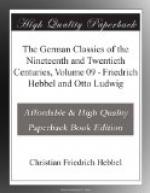In the day of Gessner, Bodmer, and the like, who saw a muse in every sheep and every herdsman, the imitation of nature was the gospel in which every one believed. This, at best, meant nothing at all, and closely analyzed, it is half nonsensical, in so far as this definition presupposes art to be something that exists outside the domain of nature. But man belongs within the domain of nature; he must be included within this domain, and at most can complete or enlarge it; and for this reason alone art can never imitate a whole of which it is a part.
Hereupon men went a step farther, and defined art as “imitation of the beautiful.” We should have less cause to object to this definition if the question on which everything depends in this case had not been left unanswered; if they had not left undecided what it was they meant by “imitation of the beautiful.” They were indeed very soon ready with an explanation, calling that “beautiful” which reveals an agreeable unity in variety. Unfortunately they could not prevail upon themselves to grant the proposition: “All is beautiful or nothing,” which follows immediately from the first; for they had overlooked the fact that the word “agreeable” was superfluous, since every unity, because it gives a clear impression and permits us to look into the unviolated order of nature, appeals to us “agreeably”—I must use this word because it expresses the least badly the feeling which I would describe. Now, however, in spite of all reluctance, they had to acknowledge that in the domain of art there were many phenomena in which no such narrow-minded imitation of the beautiful, as was demanded, could be shown to exist, but which nevertheless could not be denied recognition. It was truly remarkable how they tried to find an escape from this dilemma. They admitted that ugliness could sometimes form an ingredient in a work of art, by which means it became possible for the artist to arouse certain mixed sensations in default of purely agreeable sensations. Mark well, “in default of purely agreeable sensations!” As though the incapacity or the momentary embarrassment of the artist, and the inadequacy of a chosen subject, could do away with a law of art once recognized as supreme. It is just as though the political law-giver should modify the prohibition of stealing by the clause: “if, namely, thou canst earn something in an honest manner.” Striking it is, that even Lessing should cling to such definitions and employ all his ingenuity to prove their tenableness. It goes to show that the taste of a nation never—as may very well be imagined—precedes the genius, but always limps along behind him. Still more striking it is that they could feel the inadequacy of the accepted definition, that they could come so near to the real remedy, and yet could overlook it. It seems to me, namely, that everything could have been adjusted, if they had made the same demands on the artist’s work that they made on the subject chosen by him. This is so plain that it needs no demonstration.




